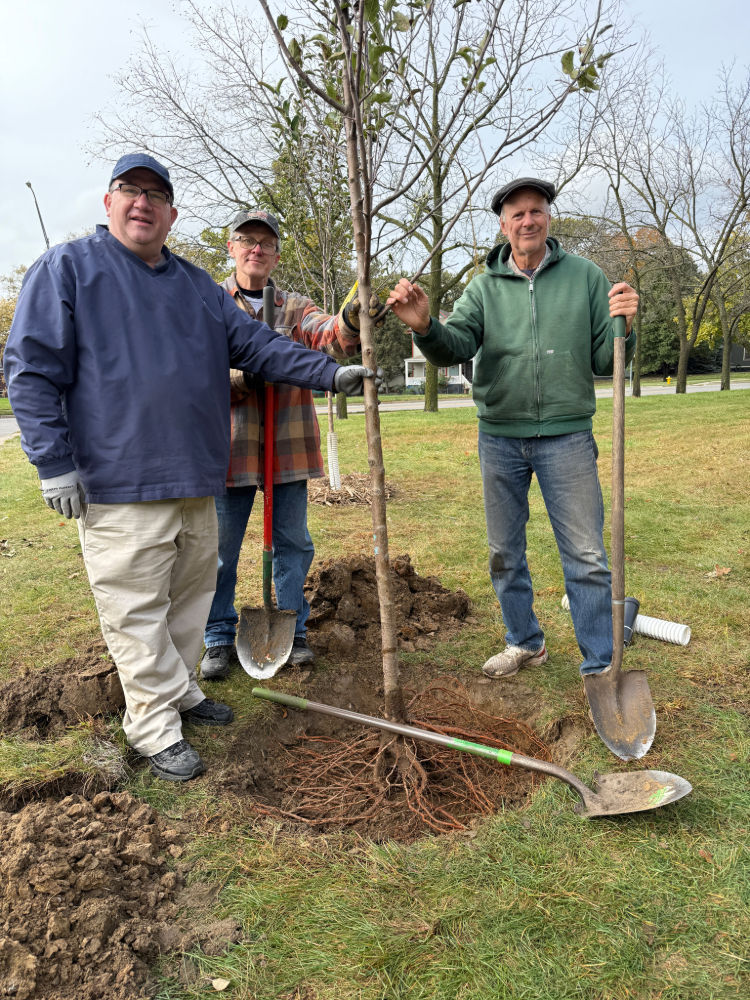
TRAINING TOWER FOR FIREFIGHTERS
Fire Marshal Jon Lund, left, and Captain Steve Kiburz stand outside the training tower that is part of the new Fire Station 4 under construction at 1505 Martin Luther King Jr. Parkway.
The $15.8 million station is expected to open in early 2026.
The five-story training tower, shown in the background, will serve firefighters from all 11 Des Moines stations. The cost to build the tower and the covered trench (below grade) is estimated at $300,000.
The tower’s one-off interior serves as a training ground for combating blazes and rescuing people in high-rise and medium-rise buildings. Jon told me Des Moines has about 100 buildings classified as high-rises—seven stories or more—and estimated there are another 100 buildings three stories or more, each with at least one elevator.
“We put about 500 hours into designing and inspecting this tower,” Jon told me. “There’s really nothing like this in the U.S. We’ve already had inquiries from Texas A&M’s Fire and Emergency Services and from Lincoln, Nebraska, to tour our tower.”
At Station 4, all firefighters will train for basic stairway rescues. The most frequent users will be members of the technical rescue squads from Stations 4 and 7, on the East Side at 500 East 12th Street, just south of East Euclid Avenue.
“With the tower, we can do more reps on rescues that are difficult and dangerous,” Jon said.
“The goal is to make the rescue safer and faster,” he added. “You might only get one rescue a year that requires rappelling down an elevator shaft and entering the car from the roof. We want as many practice sessions as possible.”
Jon said the training tower has three railings: cables, as in a parking garage; metal railings, as on balconies; and a catwalk, as the one above Casey’s Arena.
Jon told me that Captain Tim Nemmers was in on the planning from the get-go. Captain Nimmers and a small committee of DMFD personnel worked on the design and maximizing training opportunities. One committee member visited training towers in New York City and elsewhere.
So, what’s it like to design a training tower? I stopped by Substance Architecture to talk to Leah Rudolphi and Paolo Orlando, the design team.
They don’t teach anything like this in architecture school! And chances are, the tower won’t be in the running for any prestigious design award from the American Institute of Architects. “This is the most interesting, unique, and complex project I’ve been involved with,” Leah said.
The firefighters knew exactly what they wanted, Leah recalled. “It had to have a durable surface; this tower needs to shed a lot of water—650 gallons a minute. And pump the water out,” she said, continuing:
“They wanted different window dimensions. Some windows next to a corner. And imagine trying to spec elevator doors, but no elevator. Trying to get someone to sell just the doors was a challenge.”
Paola talked about the tight conditions, inside and out. “Everything is smushed together,” he told me. “There are anchors on the floor to go down an elevator shaft. Anchors on the ceiling. Anchors in the corners. And all tested so they can rappel off ledges.
“And in the adjoining station, we designed a mezzanine, so they could reconfigure the space to resemble residential, business, storage, and utility spaces.”
When I circled back to Jon, he was quick to point out the value of Station 4. “Being located in the center of the city is important,” Jon added.
“This station does two really important things for the community. First, it improves service delivery to the residents. And second, it provides a prominent building in the neighborhood to be a fixture for years to come.
“Fire stations are safe spaces, and this building has features—like the classroom—that can benefit the neighborhood for the next several decades.”

I-CUBS BULLPENS UNDER CONSTRUCTION
Since the end of the 2025 baseball season, crews have been working to build first-time bullpens on the Sec Taylor Field at Principal Park. The second week in November, crews were building a new concrete wall between right field and the new visitors’ bullpen.
Cubs general manager Randy Wehofer told me that moving the bullpens—where pitchers warm up—away from along the foul lines to protected, sealed-off areas will improve safety for relief pitchers and catchers, as well as outfielders chasing foul balls. Stumbling over the bullpen pitcher’s mound on the edge of the playing field has been a long-time hazard.
The project, decreed by Major League Baseball, will reduce Principal Park’s seating capacity from 11,000 to about 10,000.
The City of Des Moines owns Principal Park. In June, the City Council awarded the $765,000 bullpen project to BallTeam LLC, a local construction firm that was the low bidder on other recent Principal Park improvements.
Opening day is Friday, March 27. Good seats still available!

ANOTHER FIRST: URBAN ORCHARD
Ward 1 Council member Chris Coleman, Beaverdale native Patrick Krohn, and Ed Fallon were among more than 20 volunteers who descended onto Drake Park, along East 24th Street just north of the MacVicar Freeway, on October 29 to plant 30 fruit trees that are to become the City’s first urban orchard.
Volunteers planted apple, apricot, cherry, peach, pear, and plum nursery stock. Volunteers also planted shrub and single-stem serviceberry varieties.
Trees Forever will regularly water the orchard stock for two years; the City’s forestry department, which paid for the trees, will prune them.
City forester Shane McQuillan told me it will be three or four years before the cherry trees bear fruit; four or five years for the apple trees.
Darn, no pies—yet. But the fruit will be available to the community for free when the trees begin producing.
Thanks to Ed Fallon and Kathy Byrnes for bringing this idea forward.
Any ideas for a second and third urban orchard? Don’t be shy! Contact City forester Shane McQuillan.
A taste of the future: This was the first tree-planting event I’ve attended with fruit pies for the volunteers.

TWO GENERATIONS OF TEACH GRADS
Cameras were clicking on October 30 when Danterell Lamar, right, and his dad, Carl, posed for photos following graduation ceremonies for Broadlawns Medical Center’s TEACH Program (Training and Education for Adults Seeking a Career in Healthcare).
Danterrell and Carl are the first father-and-son graduates of the apprentice program that guides adults to certified nursing assistant (CNA) degrees. Carl graduated in 2024. Dad and lad work in the Broadlawns’ Inpatient Behavioral Health Department.
Broadlawns developed the program in 2016, with the first graduates in 2017; 300 have completed TEACH and TECH (Training and Education for a Career in Healthcare for high school students) programs. In 2025, 19 out of 20 TEACH participants graduated, and 37 out of 40 TECH interns graduated—a 93 percent success rate.

FOOD COMMITTEE 3.0 EARNS APPROVAL
What began as the Food Security Task Force in December 2020 is about to transform into the Food Sustainability Advisory Committee, with new duties. The City Council approved the change, elevating the group to a standing committee, at its November 17 meeting.
Breann Bye and Nick Tarpey from Development Services will staff the monthly meetings.
The City Council is expected to approve many of the nine committee members at its December 8 meeting. Vannessa Silva, above, is slated to be one. Vanessa is the produce manager at Gateway Market, 2002 Woodland Avenue, overseeing fresh produce operations, focusing on local producers and inventory management. Vannessa was a member of Food Security Task Force 2.0 and provided insight on food distribution and retail in policy discussions.
After City Council authorization, the Task Force began work in 2021. Committee members created a rich resource of information, from growing fruits and vegetables, to improving soil and building garden structures, to foraging for food in an urban environment.
The second iteration of the Food Security Task Force launched in 2024. Their work focused on City codes and ordinances that liberalized the use and promotion of urban agriculture on residential, commercial, and industrial-zoned land.
Those changes broadened the definitions of City-allowed urban agriculture uses, expanded the agricultural-based activities residents could conduct on their properties, and clarified many agricultural activities that can now be conducted “by right” without discretionary/public approval.
Breann told me the proposed committee represents a balance of experience across local agriculture, sustainability, food access, small business, and health. She told me:
“It is anticipated the new committee will focus on initiatives that expand and support urban food production, advance local food entrepreneurship and market access, strengthen community gardens and orchards, promote food-friendly policies, and improve coordinated community food access and resilience across Des Moines.
“Committee members will help shape strategic priorities and specific implementation tactics when meetings begin.”
Nick added, “Breann and I are excited to continue the City’s work on food sustainability and be liaisons between the City staff and community experts who can help us all incorporate food sustainability efforts into our lives.”
Thanks to all who contributed to the first and second Food Security Task Forces.
And don’t forget to check the City website for information as you plan your 2026 garden.

EASIER TRIPS TO LIBRARY CAFÉ
Bess Lamoreux has good reason to smile about the four new bike racks in front of the University Library Café at 3506 University Avenue.
In early June, Bess proposed bike racks there for a selfish reason: She, her husband, Tom, and daughter, Hazel, enjoy pedaling to the Library Café for grilled cheese sandwiches. In her email to me and other council members, Bess suggested bike racks for pedaling patrons, such as her family. After a round of emails, City Engineering staff upgraded Bess’ suggestion to bike racks in the right-of-way (sometimes referred to as the parking).
Full Court Press, owners and operators of the Library Café, leveraged an Invest DSM grant to split the cost of the concrete slab. The City paid for and installed the bike racks.
“This is way better than I even imagined,” Bess told me. “We like coming here every 10 days to two weeks for the grilled cheese with Havarti.”
The Library Café is just the second location outside the downtown core with racks in the City right-of-way; the Waveland Café and Waveland Tap at Polk Boulevard and University Avenue were the first.
Look for bike racks to sprout outside Carl’s Place, 1620 Woodland Avenue, in the spring.

PAGENTRY AT DIA DE LOS MUERTOS
Monica Espinosa, above, dances at the Capitol Park neighborhood’s Dia de Los Muertos (Day of the Dead) celebration on November 1 at the Ding Darling Shelter in Birdland Park. Monica, a Dowling sophomore, is a member of Danza Folklorica del Oeste that performs at local events.
Capitol Park Neighborhood Association President Dena Bennett reported that an estimated 300 attended this year’s seventh annual event.
Sophea Munguia, below, is the Danza Folklorica instructor for the program, which has 40 students. Their dresses are made in Guadalajara, Mexico, and each represents a different state.

























